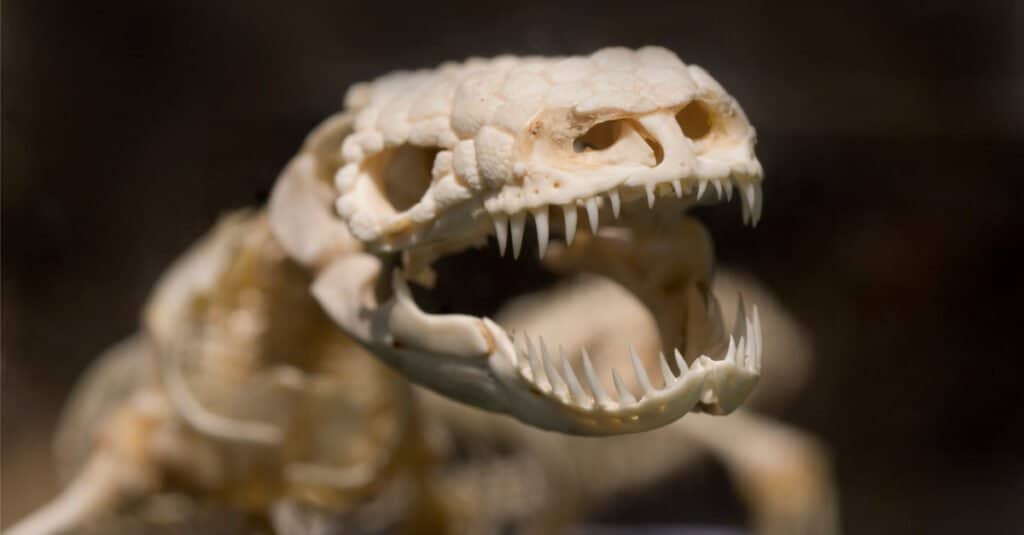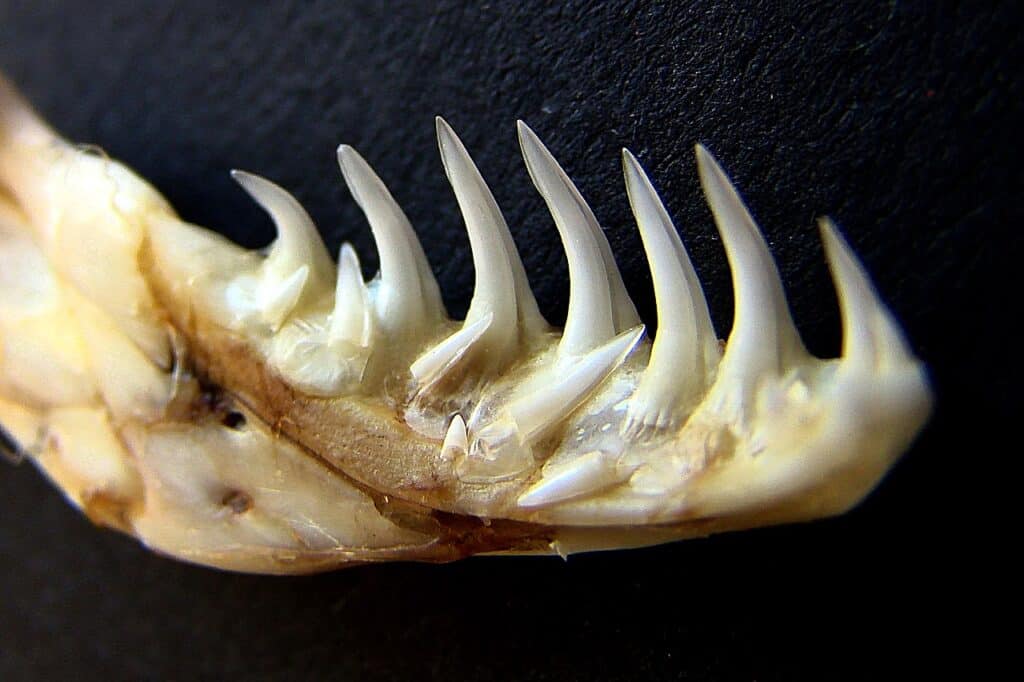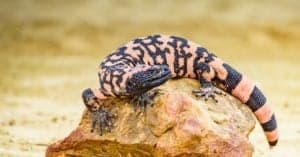Gila monsters (Heloderma suspectum) are reptiles inhabiting deserts, shrublands, and woodlands in North America, more abundantly in Arizona, California, and Mexico. Despite their name, Gila monsters are no monsters at all; in fact, they are just lizards that happen to be too big. These reptiles are one of the slowest animals in North America and the world, with their maximum speed only reaching 1.5 miles per hour. Despite their slow movement, Gila monsters are hunters in the wild, preying on small mammals, birds, bird eggs, and other reptiles. But how do these slow-moving carnivores catch their prey? The answer lies in the structure of a Gila monster’s teeth and its venom.
Gila monsters may be just lizards, but they are huge and venomous. These reptiles are one of the few venomous lizards inhabiting North America. Gila monsters are not like any other lizard. Apart from their venomous bite, Gila monsters are the largest lizards in the United States, measuring 22 inches long. Even though Gila monsters have venom, their bite is not life-threatening to humans, but they are very dangerous for other animals in the wild. What’s more interesting about these huge lizards is their way of injecting their venom onto their prey or adversary. Because Gila monsters lack fangs, they need to chew in their venom instead of just injecting it through.
Do Gila Monsters Have Teeth?

Gila monsters have sharp and pointy set of teeth
©MonsterDoc / Creative Commons – License
Gila monsters have an impressive set of teeth that are thin, pointy, and sharply tipped, almost like needles. These reptiles have teeth with flattened bases in their upper and lower jaws, but each tooth has the same appearance and structure. The teeth on their lower jaw, on the other hand, are slightly enlarged and grooved, enabling them to flow their venom on the Gila’s prey every time they bite.
The Gila monster, like most reptiles, has only one set of blade-like teeth lining both of the jaws up to the rear of the mouth. Gilas do not have molars because they do not chew their prey; instead, they use their teeth effectively in grabbing and catching their food.
A Gila monster’s bite can swiftly hold on and grip firmly. When Gila monsters bite, it may be difficult to detach their jaws from their grip. Gila monsters can keep their grip for longer than ten minutes on their victims or as self-defense against predators. Unlike snakes with hollow fangs, Gila monsters have larger, grooved teeth located at their lower mandible that release venom into their victims. Gila monsters do not inject venom in one swift move; rather, they chew their venom in through the capillary action along the trenches between their teeth, with the help of their strong jaws.
What Kind of Teeth Do Gila Monsters Have?

Gila monsters have pleurodont teeth
©iStock.com/Windzepher
There are only two types of detention in reptiles –pleurodont teeth and acrodont teeth. Gila monsters have pleurodont teeth, which means their teeth have longer roots than normal. The foundation of a Gila monster’s teeth is flat, irregularly gouged, and firmly anchored to the beveled jaw. This makes the roots of the teeth stronger but the attachment weaker as they do not directly embed to the bone.
Gila monsters grow their teeth continuously throughout their life, and whenever a tooth falls out, a replacement tooth comes in, erupting at the same space where the original one fell off. The space for teeth in the Gila monster’s jaws is of living tissue, making it continuously absorb and reform as teeth fall out and grow back in.
However, the teeth exchange in Gila monsters is not like those of other animals. Their replacement teeth erupt in wave-like patterns or batches. For instance, three of their teeth at the front portion of their jaws are replaced simultaneously. Then the next “wave” of teeth following them will be replaced next. In cases where the Gila monster’s tooth falls off by accident, it has to wait for the next set or wave of replacements to erupt again.
What Do Gila Monsters Use Their Teeth For?

The grooves in a Gila monster’s teeth helps in spreading their venom into their prey very quickly
©MonsterDoc / Creative Commons – License
Gila monsters do not have flat-crowned teeth that help them chew and grind their prey, so their sharp-tipped teeth are used only in grabbing and holding onto their victims. As venomous lizards without fangs, Gila monsters use their enlarged lower teeth with canal spaces to inject and chew their venom into their victims. These grooves in the Gila monster’s teeth aid in spreading their venom very quickly. Gilas also use their teeth in breaking eggs open.
The venom of Gila monsters may not be fatal for humans, but it can kill its animal prey in just a single bite. The Gila monster’s mild neurotoxin combined with their poisonous saliva can easily kill their prey and defend themselves against predators. They have an unsurprisingly strong bite which can be painful for humans and fatal for animals. Gila monsters hold on for several minutes, sometimes even longer than ten, and even chew in their venom.
Gila monsters use flexible, forked tongues to transport food and water into their throat. They also use their tongues to pick up scent particles in their environment. As Gila monsters are slow-moving, they sneak up on their victims and bite them, killing them with their venom.
Do Gila Monsters Bite?

Gila monsters bite humans only when they feel threatened.
©iStock.com/kwiktor
Gila monsters rarely bite humans unless they feel cornered or threatened. They tend to lash out and bite you if you come too close. Even though the Gila monster’s venom isn’t life-threatening, getting bitten still needs serious medical attention. The bite of Gila monsters is painful, as most of them grind their teeth deeply into the wound.
If a Gila monster bites you, promptly try to detach its bite from the wound by prying its mouth open with a stick. Medical attention is required to check if there is broken teeth or infection. A Gila monster’s bite can cause dizziness, vomiting, weakness, and intense burning pain in humans.
The photo featured at the top of this post is © iStock.com/Windzepher
Thank you for reading! Have some feedback for us? Contact the AZ Animals editorial team.







